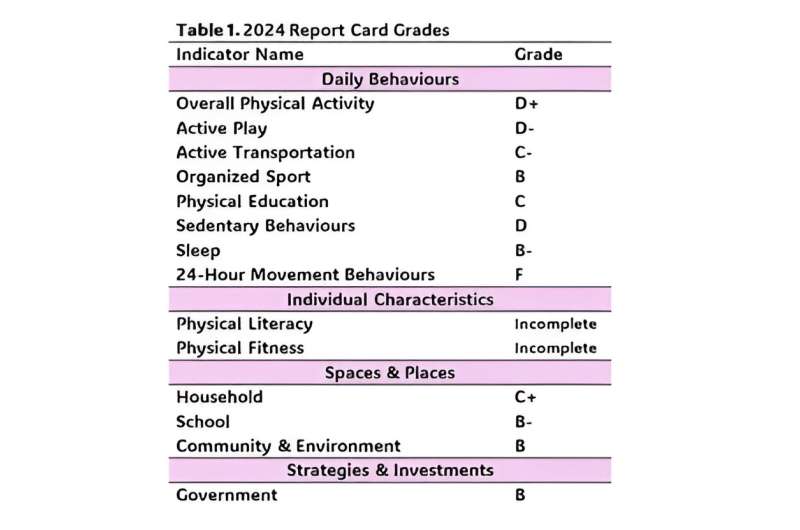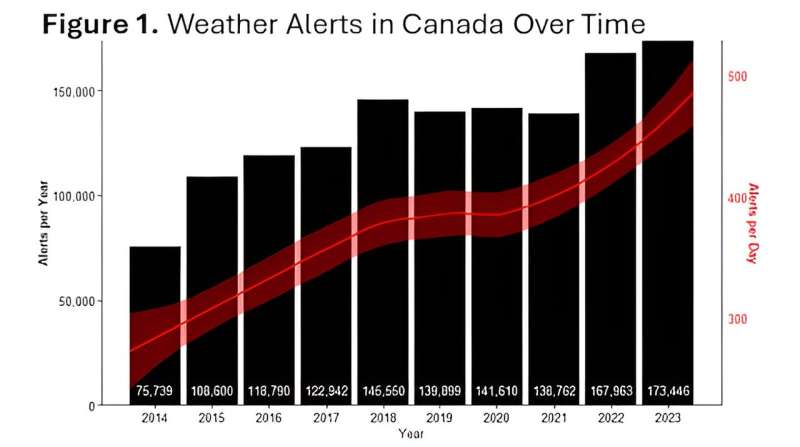This article has been reviewed according to Science X's editorial process and policies. Editors have highlighted the following attributes while ensuring the content's credibility:
fact-checked
trusted source
written by researcher(s)
proofread
Climate change is a new hurdle for children's physical activity levels in Canada

The ParticipACTION Report Card on Physical Activity for Children and Youth, the most comprehensive assessment of children's physical activity in Canada, recently gave the country a D+ in overall physical activity.
While this grade is better than the D grade given in 2022, there is still much room for improvement. The D+ resulted from only 39% of children and youth in Canada meeting the recommendation of at least 60 minutes a day of moderate-to-vigorous—or heart-pumping—physical activity.
The report, which we were involved in, synthesizes and shares the latest research on physical activity, with the goal of influencing behaviors and policies to get children living in Canada moving more and sitting less.
A team of 17 leading experts in children's physical activity, from across Canada and sectors—including academia, the government and non-government organizations—that developed the report using the best available data from multiple sources.
The report's findings show there are still a significant number of barriers hindering children and youth's ability to lead healthier, more active lifestyles in Canada.
One factor that is likely driving low physical activity rates is screen-based sedentary behavior, which received a D grade in this year's report. Only 27% of children and youth met the recommendation of less than two hours per day recreational screen time.
Inequality and physical activity
The increased physical activity grade was not a universal increase across all equity-denied groups.
National data indicated that physical activity decreased for boys and girls during the pandemic: 37% of children were active in the fall of 2020, compared to 50% pre-pandemic.
However, only boys' physical activity levels have rebounded: 52% of boys were physically active in 2021, compared to 40% in 2020. Girls remained stagnant at 35% in 2021 and 2020.
Additionally, only 55% of parents from the lowest-income households reported that their children participated in organized sports within the last year, compared to 86% of parents from the highest-income households.
Climate change
With already low grades for children's physical activity, climate change is emerging as a new barrier for children and youth to get more active.
For instance, the number of weather alerts in Canada is rapidly trending upwards, which could indicate an increased number of days where kids can't play outside, recesses take place indoors, and sports and school days are cancelled.
Events like poor air quality from wildfire smoke, heat waves and heat domes are becoming more frequent during the summer, with climate scientists predicting they will only grow more intense.

Children, compared to adults, are also more vulnerable to climate-related weather events based on their smaller airways and need to breathe more rapidly, which could put them at greater risk of inhaling more pollutants and subsequent lung diseases.
Beyond the risks, physical activity can help planetary health and resilience for children. For instance, physical activities such as active transport and gardening can provide benefits to the individual and for planetary health.
Additionally, the more time a child spends outdoors the more active they are, and the more their connection with nature increases. This can lead to raising a generation of more pro-environmental adults. Regular physical activity can also make children more resilient to the rising temperatures associated with climate change.
Comparing grades
Examining grades across 57 countries around the world in 2022, Canada's overall physical activity grade (D) was below average compared to other very high Human Development Index countries. Overall, 27 countries scored higher than Canada.
The two highest scoring countries were Slovenia and Sweden with an A-. Potential reasons for these higher grades included Slovenia's strong infrastructure in the community and quality physical education in the schools.
Meanwhile, the importance of physical activity has permeated many facets of Finland's culture. It's strongly emphasized in education training, policies, strategies and national health promotion programs.
If Canada strives to make physical activity a cultural norm, it has much to learn from Slovenia and Finland.
Improving physical activity in Canada
The 2024 ParticipACTION Report Card makes a number of recommendations for improving physical activity in Canada, including climate change-specific recommendations. While climate change presents obstacles for children's physical activity levels, there are ways to help children and youth stay active while building resilience.
For parents and caregivers, the report suggests replacing sedentary and screen time with indoor active play during climate events that limit outdoor play and organized sports. Caregivers can also come up with indoor activity plans and go to local recreation centers.
By facilitating discussions about climate change and engaging in outdoor activities, parents and caregivers can also reduce eco-anxiety and foster a greater understanding and appreciation of environmental conservation.
Organized sport programmers can implement heat warning systems, and develop clear, easy-to-action guidelines and policies for adverse weather events.
Schools are encouraged to implement daily physical activity policies and strategies to safeguard active play when recess is relocated indoors due to climate-related risks.
Governments have a role to play in investing more in active transportation infrastructure—which, in turn, would reduce carbon emissions and pollution—national and provincial parks, trails, and recreation and sport facilities to improve access to physical activity opportunities for children, youth and families.
Lastly, all sectors should invest in health promotion initiatives that consider climate change implications on physical activity among children and youth, with specific emphasis on equity-denied communities, to make physical activity more accessible for all in the face of a changing climate.
This article is republished from The Conversation under a Creative Commons license. Read the original article.![]()





















